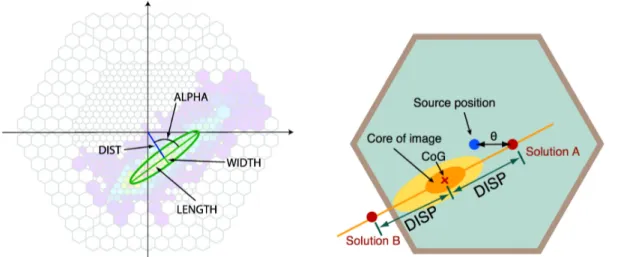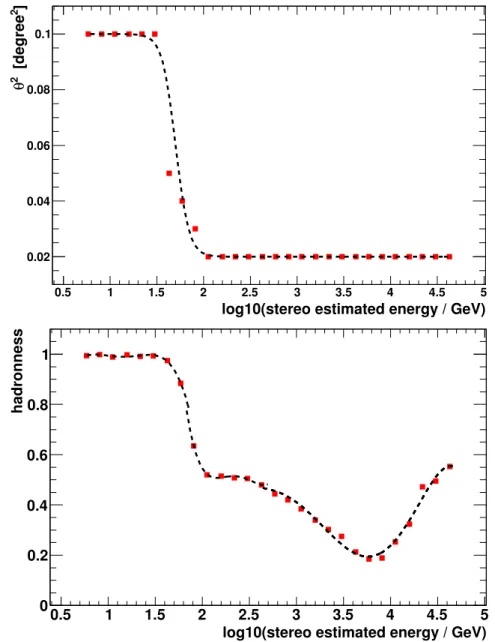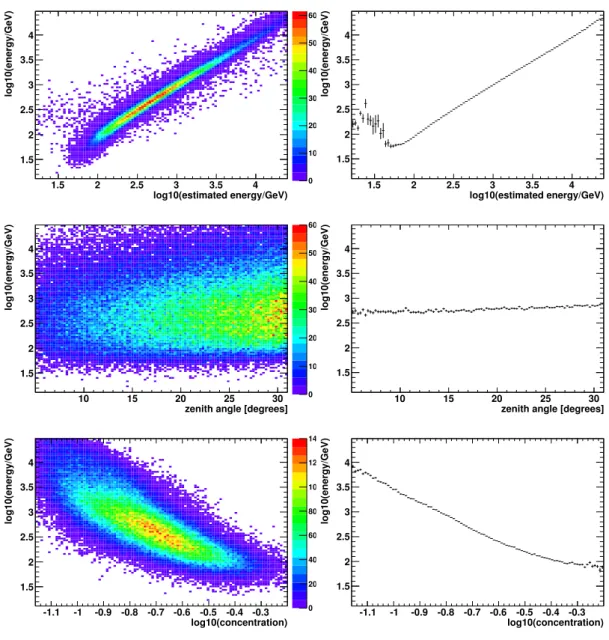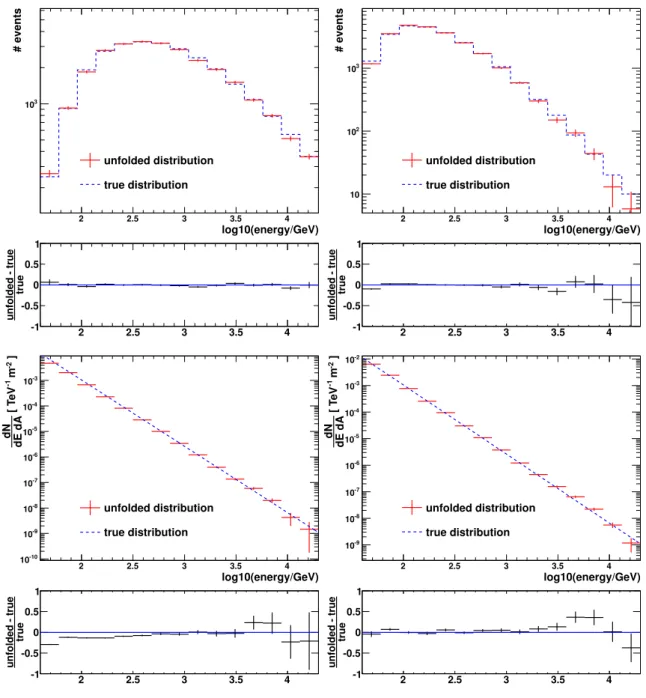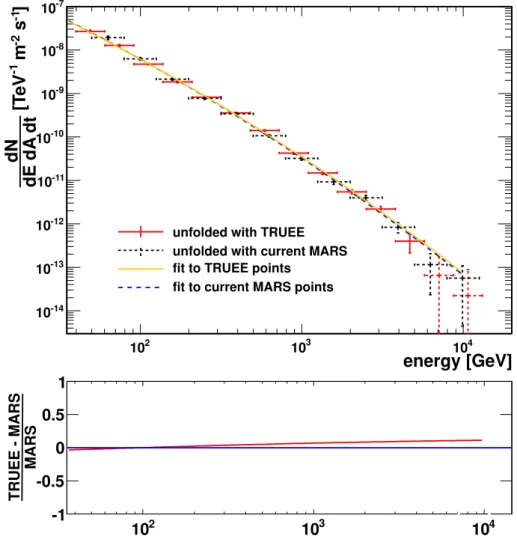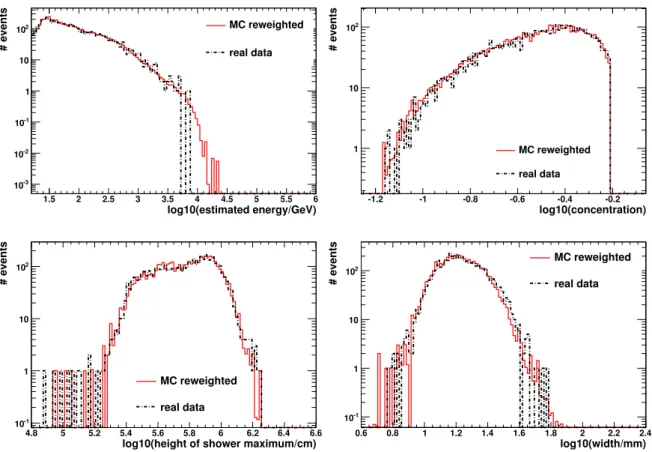Fakultät Physik – Experimentelle Physik V
The talkative AGN next door
Broad-band spectral variability of the TeV blazar Markarian 501
Dissertation
zur Erlangung des akademischen Grades eines
Doktors der Naturwissenschaften (Dr. rer. nat.)
vorgelegt von
Dipl.-Phys. Marlene Doert
Februar 2013
Contents
1 Introduction 1
2 Astroparticle Physics Briefly 3
2.1 The Messengers . . . . 3
2.1.1 Charged cosmic rays . . . . 4
2.1.2 Cosmic gamma-rays . . . . 5
2.1.3 Neutrinos . . . . 6
2.2 The Processes . . . . 6
2.2.1 Particle acceleration - Fermi I and II . . . . 7
2.2.2 Synchrotron radiation . . . . 7
2.2.3 (Inverse) Compton scattering . . . . 8
2.2.4 γγ-absorption . . . . 8
2.2.5 Photo-hadronic interactions . . . . 9
2.2.6 Electromagnetic cascades . . . . 9
2.3 The Sources . . . . 10
2.3.1 Supernova remnants . . . . 10
2.3.2 Binary systems . . . . 10
2.3.3 Galactic center . . . . 10
2.3.4 Active galaxies . . . . 11
2.3.5 Gamma-ray bursts . . . . 11
2.3.6 Starburst galaxies . . . . 11
2.3.7 Candidates for CR emission - the Hillas plot . . . . 11
3 Gamma-ray Astronomy with the MAGIC Telescopes 13 3.1 The Imaging Air Cherenkov Technique . . . . 13
3.2 The MAGIC Telescopes . . . . 15
3.2.1 Design/Construction . . . . 15
3.2.2 Operation . . . . 16
3.3 MAGIC Analysis . . . . 17
3.3.1 Analysis goals . . . . 17
3.3.2 Monte Carlo simulations . . . . 17
3.3.3 Data quality selection . . . . 18
3.3.4 Calibration . . . . 18
3.3.5 Image cleaning and characterization . . . . 18
3.3.6 Stereo parameters . . . . 19
3.3.7 Background suppression and energy estimation . . . . 19
i
3.3.10 Reconstruction of the energy spectrum . . . . 22
4 TRUEE - Unfolding gamma-ray energy spectra 23 4.1 Unfolding - Definition and Motivation . . . . 23
4.2 Inverse problems . . . . 24
4.3 Unfolding and Regularization . . . . 25
4.3.1 Discretization . . . . 25
4.3.2 Determining the response matrix . . . . 26
4.3.3 Matrix inversion versus unfolding fit . . . . 26
4.3.4 Regularization . . . . 28
4.3.5 Alternative method: Forward Folding . . . . 29
4.4 TRUEE . . . . 29
4.4.1 Parametrization using splines . . . . 30
4.4.2 The response matrix . . . . 30
4.4.3 Choice of observables . . . . 30
4.4.4 Parameter selection . . . . 31
4.4.5 Treatment of background . . . . 32
4.4.6 Acceptance correction . . . . 32
4.4.7 Verification with a posteriori observable distributions . . . . 32
4.4.8 Test mode . . . . 33
4.5 TRUEE Unfolding in MAGIC . . . . 34
4.5.1 Present MAGIC unfolding . . . . 34
4.5.2 Motivation for unfolding with TRUEE . . . . 35
4.5.3 Incorporation of TRUEE in the MAGIC analysis chain . . . . 35
4.6 First application of TRUEE in a MAGIC analysis . . . . 40
4.6.1 Utilized data and Monte Carlo samples . . . . 41
4.6.2 Preparation with made-up: Cuts . . . . 41
4.6.3 Choice of observables . . . . 42
4.6.4 Application on Monte Carlo simulated data . . . . 44
4.6.5 Application on Crab Nebula data . . . . 47
4.6.6 Verification using observable distributions . . . . 49
4.7 Conclusion . . . . 50
5 The Active Galaxy Markarian 501 - a talkative blazar in our neighborhood 51 5.1 Active Galactic Nuclei . . . . 51
5.2 Blazars . . . . 53
5.2.1 Blazar sequence . . . . 54
5.2.2 Acceleration and emission models . . . . 55
5.2.3 Blazars: the secrets they still keep . . . . 56
5.3 Markarian 501 . . . . 57
6 MWL Campaign on Mrk 501 in 2009 59 6.1 Motivation and Introduction . . . . 59
ii
6.2 MAGIC data analysis . . . . 60
6.2.1 Data selection . . . . 60
6.2.2 Off-data sample . . . . 61
6.2.3 Monte Carlo selection and RF training . . . . 61
6.2.4 Flux variability analysis . . . . 63
6.2.5 Spectral analysis . . . . 66
6.3 Multi-instrument data set . . . . 68
6.4 Summary on average state results . . . . 68
6.5 MWL flux variability . . . . 69
6.5.1 Outbursts in the X-ray and VHE band . . . . 72
6.5.2 Variability analysis . . . . 74
6.5.3 MWL correlations . . . . 74
6.6 MWL spectral variability . . . . 76
6.6.1 VHE gamma-rays . . . . 78
6.6.2 X-rays . . . . 78
6.6.3 Evolution of SEDs . . . . 82
6.7 Modeling . . . . 84
6.8 Summary . . . . 88
6.9 Discussion . . . . 89
6.10 Conclusion . . . . 93
7 AGN: Sources of neutrinos and charged cosmic rays? 95 7.1 Motivation and Introduction . . . . 95
7.2 The Process . . . . 96
7.3 The Method . . . . 97
7.4 Application to data . . . . 98
7.4.1 Data selection . . . . 98
7.4.2 Parametrization of the high energy bump . . . . 98
7.4.3 Flux normalization via integration . . . . 98
7.4.4 Resulting neutrino fluxes . . . . 99
7.4.5 How many events could IceCube see? . . . . 99
7.5 Discussion and Conclusion . . . . 100
8 Final Conclusion and Outlook 103
A Cuts for new spectral reconstruction method 105
B MWL analysis of Mrk 501 107
List of Figures I
List of Tables III
Bibliography V
Author’s Publications XIX
iii
Acknowledgment/Danksagung XXIII
iv
Chapter 1
Introduction
Astroparticle physics is a comparably young field of research, which unites scientists from the domain of particle physics and from the area of astronomy and astrophysics. Just after the celebration of its 100 th anniversary in the year 2012, astroparticle physics continues to be an active and fast-growing field, which promises not only to provide deeper insights into the most powerful environments within our Universe, but also to deliver results at the interface of searches for new physics in various different fields. Ultimately, this synergy will help us to understand the evolution, constitution and the future of our Universe.
Within astroparticle physics, the field of gamma-ray astronomy can be seen as the natural extension of “conventional” astronomy, which mankind has pursued probably ever since by exploring the night sky with the naked eye or, later on, through the help of telescopes.
In the last century, the accessible part of the electromagnetic spectrum has been expanded beyond visible light by the use of radio telescopes and satellite experiments. Gamma-ray astronomy now allows to probe the very end of the electromagnetic spectrum and can thus give insights into the most energetic phenomena in the Universe. After the technique passed its proof of principle only a few decades ago, the exploration of the gamma-ray sky is now entering a Golden Age, as experiments are at hand which are sensitive enough to allow for deep studies of cosmological objects, such as the black holes sitting at the center of active galaxies.
The work performed in the scope of this thesis has been dedicated to a better under- standing of the phenomenon of active galactic nuclei (AGN). These objects stand out by producing a powerful and highly variable output over the entire electromagnetic spectrum, while being one of the most favored candidates for the sources of the highest energetic cosmic radiation in charged particles. A better understanding of these objects will pave the way for detailed studies of the evolution of the cosmos and the discovery of new fun- damental physics phenomena.
The subject of AGN has been approached via the example of the TeV blazar Markarian 501, which presents itself as the ideal candidate for deep studies of the intrinsic mechanisms at work, by its vicinity and high variability.
The work which is presented in this thesis is anchored in the field of gamma-ray astronomy, as it has been performed within the collaboration of the MAGIC experiment. Still, besides the cooperation with groups exploring the other bands of the electromagnetic spectrum in a multi-wavelength study, the connection to another area of astroparticle physics re- search, namely the field of neutrino astronomy, has been pursued in the context of the multi-messenger approach.
1
The thesis is organized as follows:
Chapter 2 gives a brief overview of the field of astroparticle physics. The different messenger particles are introduced, the relevant basic mechanisms by which they are ac- celerated, produced, deflected or attenuated are outlined and the different types of sources which are currently being studied are briefly discussed.
A preface to the principles of air showers and Cherenkov gamma-ray astronomy is given in Chapter 3, followed by an introduction of the MAGIC experiment. The experimental setup of the two-telescope system as well as the basic analysis procedure are illustrated here.
In Chapter 4, the theme of inverse problems is outlined, followed by an introduction into the method of regularized unfolding. After a brief presentation of the novel unfolding program TRUEE, the incorporation of the program into the standard MAGIC analysis chain is discussed, which has been a major project in the course of this thesis. Sub- sequently, the first application of the new unfolding chain on MAGIC telescope data is presented.
Being one of the major candidates discussed in the preceding chapters, Chapter 5 intro- duces the source class of AGN and blazars in particular, summarizing their observational properties throughout the electromagnetic spectrum. The current state of research and the open questions are outlined. The object Markarian 501, which is subject to two studies which have been performed in the course of this thesis, following quite different approaches, is introduced here.
Chapter 6 presents a multi-instrument campaign on Markarian 501, which has been another major project in the scope of this thesis. At first, the results of an analysis of the corresponding MAGIC data are shown. Subsequently, the multi-instrument data set is discussed, including detailed studies of variability and inter-band correlations, spectral variability and the evolution of the broad-band spectral energy distribution during flaring episodes. The results are discussed in the light of leptonic emission models, based on previ- ous works on this data set, and in the context of similar results seen in other source classes.
Chapter 7 approaches Markarian 501, and the blazar class in general, from a contrary point of view, assuming hadronic interactions and the consequential production of neutri- nos. An estimation for a possible neutrino signal from such processes is pursued, while only simple bolometric considerations are used. The results, which are obtained on the basis of the data set presented in the preceding chapter, are discussed in the context of state-of-the-art neutrino astronomy.
After detailed discussions of results and conclusions are given at the end of the respective
chapters, Chapter 8 concludes the thesis and provides a brief outlook to possible future
activities based on the presented work.
Chapter 2
Astroparticle Physics Briefly
The first step into the field of astroparticle physics was taken by V. Hess in 1912, when he discovered that ionizing radiation, which he called Höhenstrahlung, is reaching us from space [Hes12]. Further findings which were linked to measurements of astroparticles, like the discovery of the muon, the pion and the positron, have had great influence on the development of particle physics. Nowadays, astroparticle physics has emerged to be a vivid, still young, field of research. It has grown to be an advantageous combination of astrophysics and particle physics, from which both “parent” fields substantially profit.
The possible channels to study astrophysical sources have been expanded by very high energy photons, neutrinos and potentially charged particles such as the highest energy protons. These new messengers give access to the most powerful phenomena in our Uni- verse, and will contribute to understanding extreme events such as supernova explosions and gamma-ray bursts, but also the fascinating phenomenon of black holes, their influence on the formation of galaxies and ultimately the formation of the Universe that we know today.
On the other hand, cosmic accelerators can be exploited to study particle physics at energy scales beyond anything possible to establish in man-made machines. Once the sources of the highest energy cosmic rays are found and a reasonable understanding is acquired, they could be promising cosmic laboratories which offer accelerated particles at outstandingly high energies and even “for free”, while of course posing the challenge of an uncontrollable and probably unpredictable particle beam.
For a detailed introduction into the field of astroparticle physics, see for example [FR12]
and [BG06], which served as the basic references for the following sections.
2.1 The Messengers
The messenger particles which are addressed in the context of astroparticle physics, namely the charged cosmic rays, highest energy photons and neutrinos, have very different char- acteristics, which give them distinct advantages (and disadvantages) for studying different aspects of the highest energy phenomena. In the following, a short overview of the particles and their major properties is given.
3
00000000 00000000 0000 11111111 11111111 1111 000000 000000 000 111111 111111 111
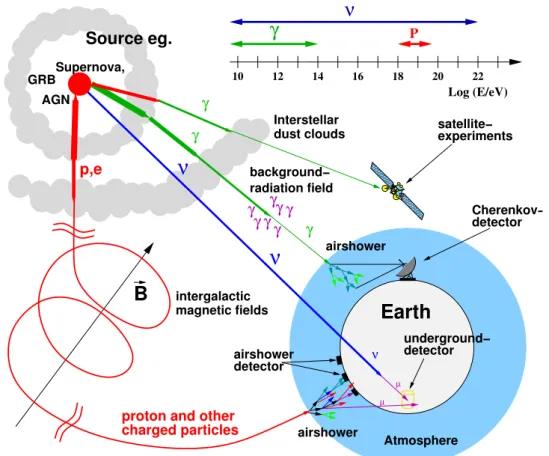
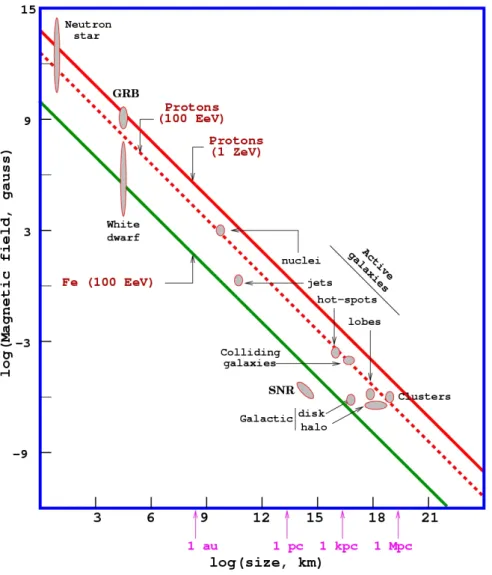
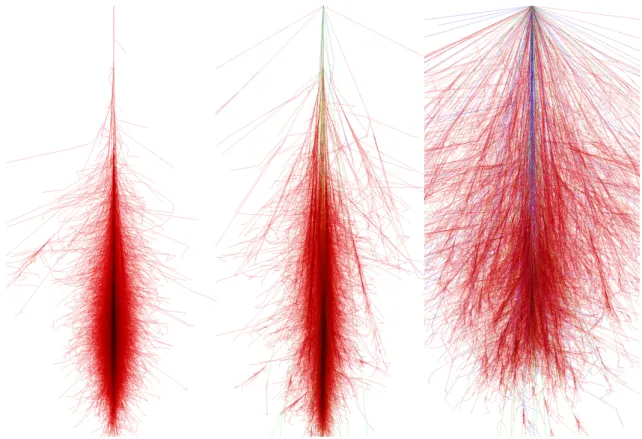
![Figure 3.2: Photograph of the MAGIC telescopes on the Roque de los Muchachos in La Palma de Canarias [Wag09].](https://thumb-eu.123doks.com/thumbv2/1library_info/3634075.1502355/21.892.201.748.309.664/figure-photograph-magic-telescopes-roque-muchachos-palma-canarias.webp)
